BSBLDR403 Assessment 1: Lead Team Effectiveness - Upskilled 2015
VerifiedAdded on 2022/01/07
|7
|1568
|146
Homework Assignment
AI Summary
This document provides a comprehensive solution to the BSBLDR403 Assessment 1, focusing on lead team effectiveness. The assignment addresses various leadership styles, distinguishing between "hands-on" and "hands-off" approaches based on different contexts. It explores the differences between leading and managing, identifying key leadership skills, and analyzing delegation strategies, including tasks that should or should not be delegated. The solution defines SMART goals and applies them to a sales scenario, along with identifying Key Performance Indicators (KPIs) for customer satisfaction. It also examines team productivity issues, suggesting actionable steps for improvement, and explains Bruce Tuckman's stages of team development, outlining the team leader's role in each stage. Finally, it provides a strategy for handling a "Complainer" team role, emphasizing motivation and constructive redirection. The solution is a detailed response to the assessment questions, providing valuable insights into leadership and team management principles.
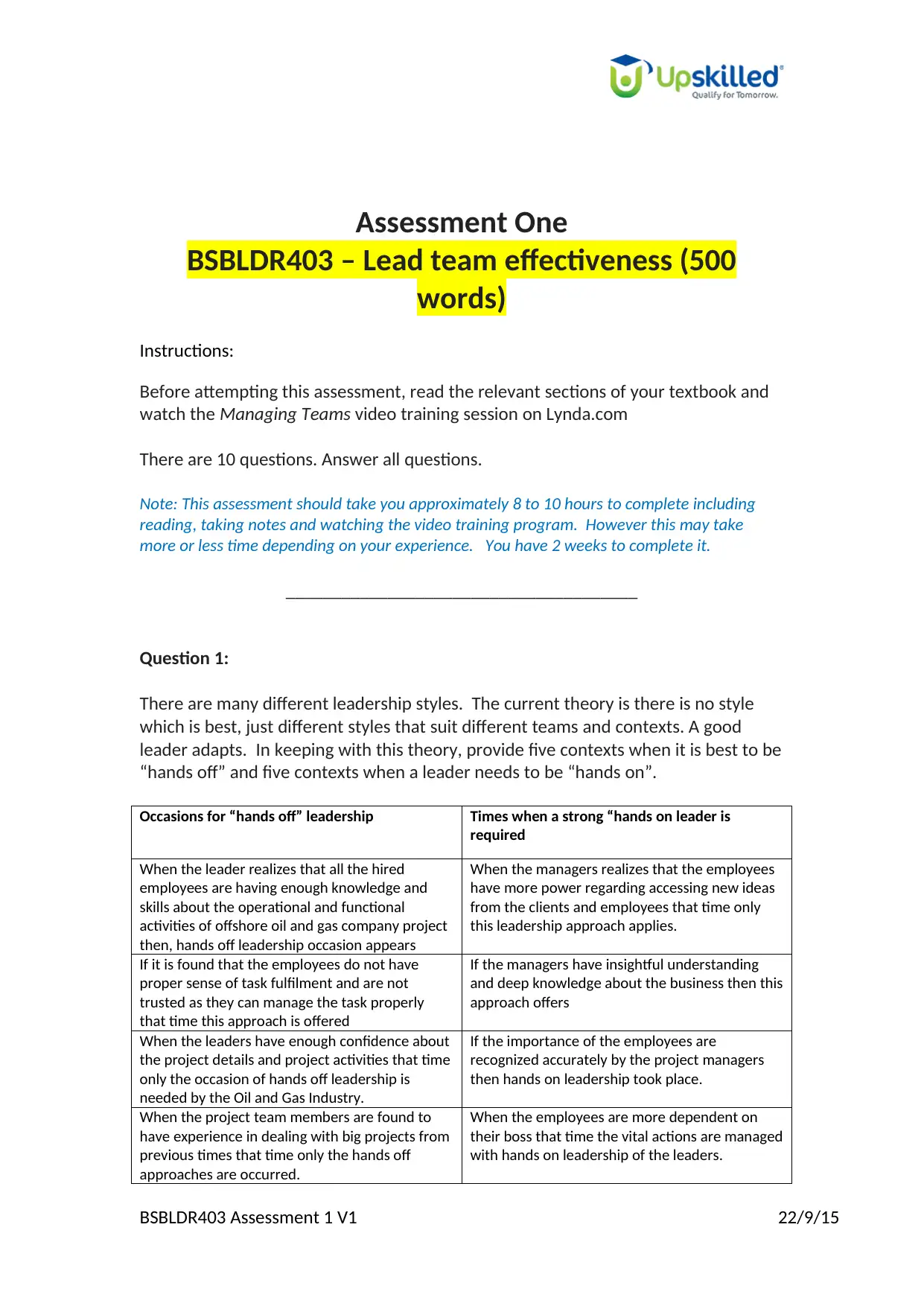
Assessment One
BSBLDR403 – Lead team effectiveness (500
words)
Instructions:
Before attempting this assessment, read the relevant sections of your textbook and
watch the Managing Teams video training session on Lynda.com
There are 10 questions. Answer all questions.
Note: This assessment should take you approximately 8 to 10 hours to complete including
reading, taking notes and watching the video training program. However this may take
more or less time depending on your experience. You have 2 weeks to complete it.
______________________________________
Question 1:
There are many different leadership styles. The current theory is there is no style
which is best, just different styles that suit different teams and contexts. A good
leader adapts. In keeping with this theory, provide five contexts when it is best to be
“hands off” and five contexts when a leader needs to be “hands on”.
Occasions for “hands off” leadership Times when a strong “hands on leader is
required
When the leader realizes that all the hired
employees are having enough knowledge and
skills about the operational and functional
activities of offshore oil and gas company project
then, hands off leadership occasion appears
When the managers realizes that the employees
have more power regarding accessing new ideas
from the clients and employees that time only
this leadership approach applies.
If it is found that the employees do not have
proper sense of task fulfilment and are not
trusted as they can manage the task properly
that time this approach is offered
If the managers have insightful understanding
and deep knowledge about the business then this
approach offers
When the leaders have enough confidence about
the project details and project activities that time
only the occasion of hands off leadership is
needed by the Oil and Gas Industry.
If the importance of the employees are
recognized accurately by the project managers
then hands on leadership took place.
When the project team members are found to
have experience in dealing with big projects from
previous times that time only the hands off
approaches are occurred.
When the employees are more dependent on
their boss that time the vital actions are managed
with hands on leadership of the leaders.
BSBLDR403 Assessment 1 V1 22/9/15
BSBLDR403 – Lead team effectiveness (500
words)
Instructions:
Before attempting this assessment, read the relevant sections of your textbook and
watch the Managing Teams video training session on Lynda.com
There are 10 questions. Answer all questions.
Note: This assessment should take you approximately 8 to 10 hours to complete including
reading, taking notes and watching the video training program. However this may take
more or less time depending on your experience. You have 2 weeks to complete it.
______________________________________
Question 1:
There are many different leadership styles. The current theory is there is no style
which is best, just different styles that suit different teams and contexts. A good
leader adapts. In keeping with this theory, provide five contexts when it is best to be
“hands off” and five contexts when a leader needs to be “hands on”.
Occasions for “hands off” leadership Times when a strong “hands on leader is
required
When the leader realizes that all the hired
employees are having enough knowledge and
skills about the operational and functional
activities of offshore oil and gas company project
then, hands off leadership occasion appears
When the managers realizes that the employees
have more power regarding accessing new ideas
from the clients and employees that time only
this leadership approach applies.
If it is found that the employees do not have
proper sense of task fulfilment and are not
trusted as they can manage the task properly
that time this approach is offered
If the managers have insightful understanding
and deep knowledge about the business then this
approach offers
When the leaders have enough confidence about
the project details and project activities that time
only the occasion of hands off leadership is
needed by the Oil and Gas Industry.
If the importance of the employees are
recognized accurately by the project managers
then hands on leadership took place.
When the project team members are found to
have experience in dealing with big projects from
previous times that time only the hands off
approaches are occurred.
When the employees are more dependent on
their boss that time the vital actions are managed
with hands on leadership of the leaders.
BSBLDR403 Assessment 1 V1 22/9/15
Paraphrase This Document
Need a fresh take? Get an instant paraphrase of this document with our AI Paraphraser

BSBLDR403 Assessment 1 V1 22/9/15
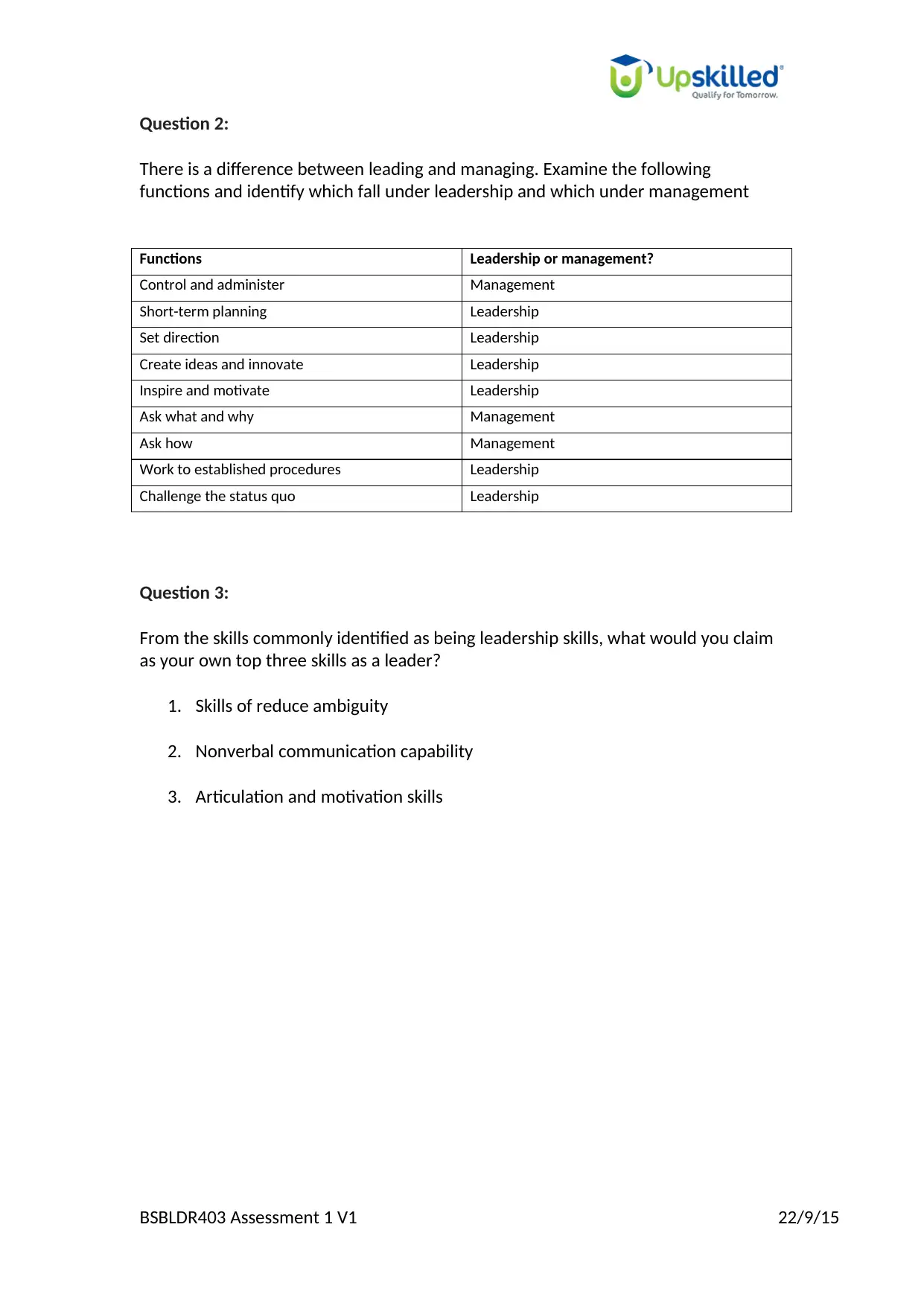
Question 2:
There is a difference between leading and managing. Examine the following
functions and identify which fall under leadership and which under management
Functions Leadership or management?
Control and administer Management
Short-term planning Leadership
Set direction Leadership
Create ideas and innovate Leadership
Inspire and motivate Leadership
Ask what and why Management
Ask how Management
Work to established procedures Leadership
Challenge the status quo Leadership
Question 3:
From the skills commonly identified as being leadership skills, what would you claim
as your own top three skills as a leader?
1. Skills of reduce ambiguity
2. Nonverbal communication capability
3. Articulation and motivation skills
BSBLDR403 Assessment 1 V1 22/9/15
There is a difference between leading and managing. Examine the following
functions and identify which fall under leadership and which under management
Functions Leadership or management?
Control and administer Management
Short-term planning Leadership
Set direction Leadership
Create ideas and innovate Leadership
Inspire and motivate Leadership
Ask what and why Management
Ask how Management
Work to established procedures Leadership
Challenge the status quo Leadership
Question 3:
From the skills commonly identified as being leadership skills, what would you claim
as your own top three skills as a leader?
1. Skills of reduce ambiguity
2. Nonverbal communication capability
3. Articulation and motivation skills
BSBLDR403 Assessment 1 V1 22/9/15
⊘ This is a preview!⊘
Do you want full access?
Subscribe today to unlock all pages.

Trusted by 1+ million students worldwide
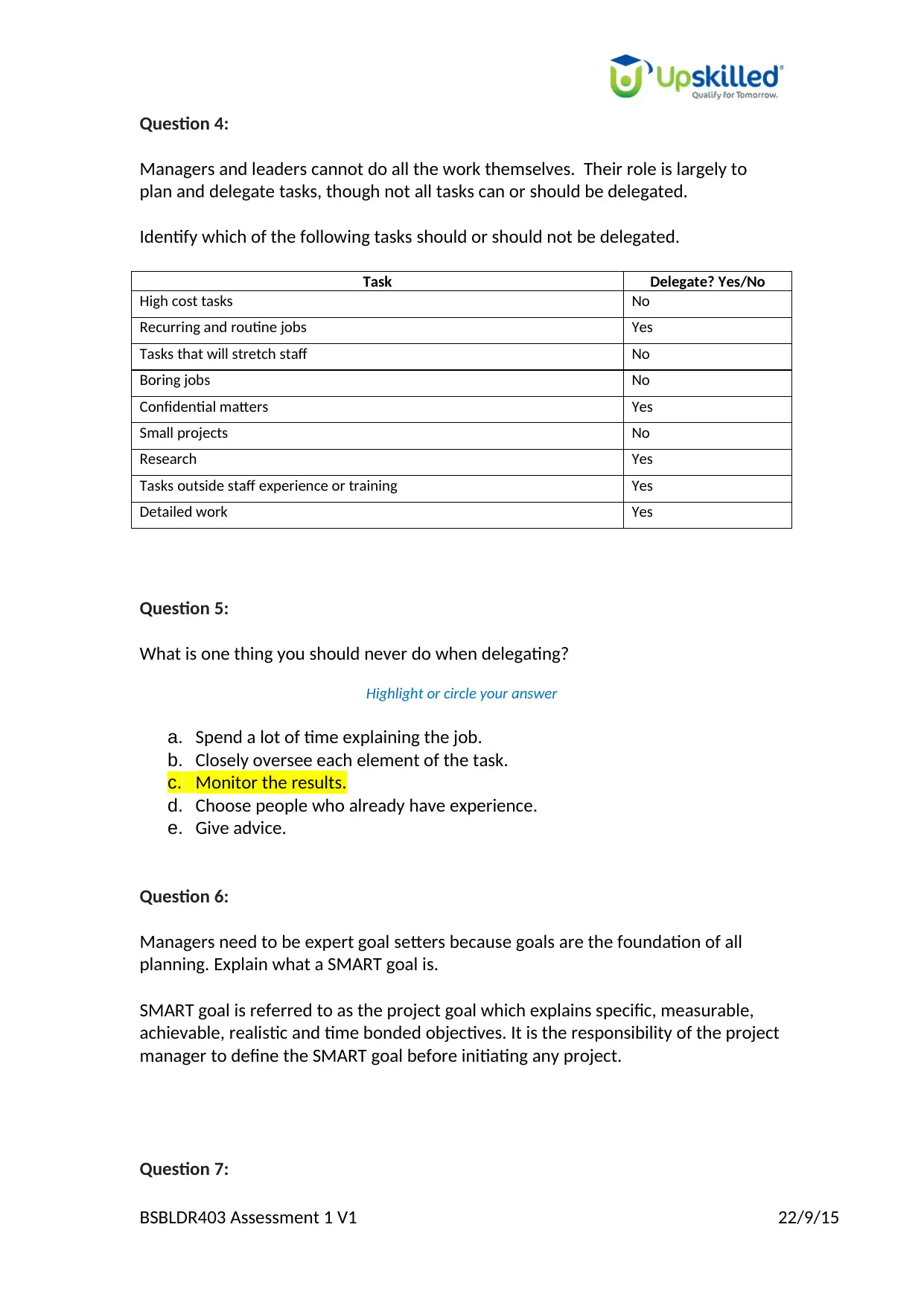
Question 4:
Managers and leaders cannot do all the work themselves. Their role is largely to
plan and delegate tasks, though not all tasks can or should be delegated.
Identify which of the following tasks should or should not be delegated.
Task Delegate? Yes/No
High cost tasks No
Recurring and routine jobs Yes
Tasks that will stretch staff No
Boring jobs No
Confidential matters Yes
Small projects No
Research Yes
Tasks outside staff experience or training Yes
Detailed work Yes
Question 5:
What is one thing you should never do when delegating?
Highlight or circle your answer
a. Spend a lot of time explaining the job.
b. Closely oversee each element of the task.
c. Monitor the results.
d. Choose people who already have experience.
e. Give advice.
Question 6:
Managers need to be expert goal setters because goals are the foundation of all
planning. Explain what a SMART goal is.
SMART goal is referred to as the project goal which explains specific, measurable,
achievable, realistic and time bonded objectives. It is the responsibility of the project
manager to define the SMART goal before initiating any project.
Question 7:
BSBLDR403 Assessment 1 V1 22/9/15
Managers and leaders cannot do all the work themselves. Their role is largely to
plan and delegate tasks, though not all tasks can or should be delegated.
Identify which of the following tasks should or should not be delegated.
Task Delegate? Yes/No
High cost tasks No
Recurring and routine jobs Yes
Tasks that will stretch staff No
Boring jobs No
Confidential matters Yes
Small projects No
Research Yes
Tasks outside staff experience or training Yes
Detailed work Yes
Question 5:
What is one thing you should never do when delegating?
Highlight or circle your answer
a. Spend a lot of time explaining the job.
b. Closely oversee each element of the task.
c. Monitor the results.
d. Choose people who already have experience.
e. Give advice.
Question 6:
Managers need to be expert goal setters because goals are the foundation of all
planning. Explain what a SMART goal is.
SMART goal is referred to as the project goal which explains specific, measurable,
achievable, realistic and time bonded objectives. It is the responsibility of the project
manager to define the SMART goal before initiating any project.
Question 7:
BSBLDR403 Assessment 1 V1 22/9/15
Paraphrase This Document
Need a fresh take? Get an instant paraphrase of this document with our AI Paraphraser
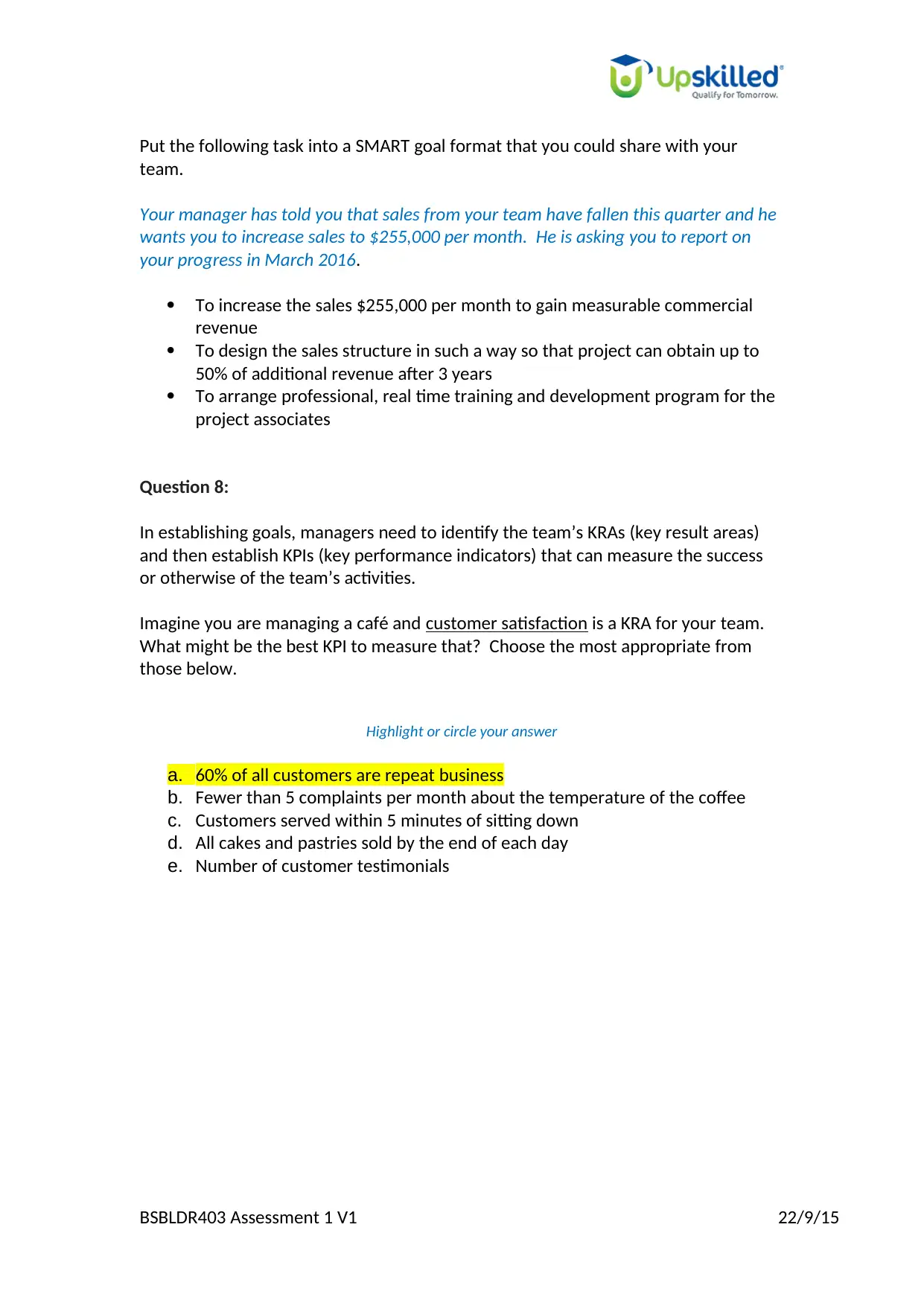
Put the following task into a SMART goal format that you could share with your
team.
Your manager has told you that sales from your team have fallen this quarter and he
wants you to increase sales to $255,000 per month. He is asking you to report on
your progress in March 2016.
To increase the sales $255,000 per month to gain measurable commercial
revenue
To design the sales structure in such a way so that project can obtain up to
50% of additional revenue after 3 years
To arrange professional, real time training and development program for the
project associates
Question 8:
In establishing goals, managers need to identify the team’s KRAs (key result areas)
and then establish KPIs (key performance indicators) that can measure the success
or otherwise of the team’s activities.
Imagine you are managing a café and customer satisfaction is a KRA for your team.
What might be the best KPI to measure that? Choose the most appropriate from
those below.
Highlight or circle your answer
a. 60% of all customers are repeat business
b. Fewer than 5 complaints per month about the temperature of the coffee
c. Customers served within 5 minutes of sitting down
d. All cakes and pastries sold by the end of each day
e. Number of customer testimonials
BSBLDR403 Assessment 1 V1 22/9/15
team.
Your manager has told you that sales from your team have fallen this quarter and he
wants you to increase sales to $255,000 per month. He is asking you to report on
your progress in March 2016.
To increase the sales $255,000 per month to gain measurable commercial
revenue
To design the sales structure in such a way so that project can obtain up to
50% of additional revenue after 3 years
To arrange professional, real time training and development program for the
project associates
Question 8:
In establishing goals, managers need to identify the team’s KRAs (key result areas)
and then establish KPIs (key performance indicators) that can measure the success
or otherwise of the team’s activities.
Imagine you are managing a café and customer satisfaction is a KRA for your team.
What might be the best KPI to measure that? Choose the most appropriate from
those below.
Highlight or circle your answer
a. 60% of all customers are repeat business
b. Fewer than 5 complaints per month about the temperature of the coffee
c. Customers served within 5 minutes of sitting down
d. All cakes and pastries sold by the end of each day
e. Number of customer testimonials
BSBLDR403 Assessment 1 V1 22/9/15
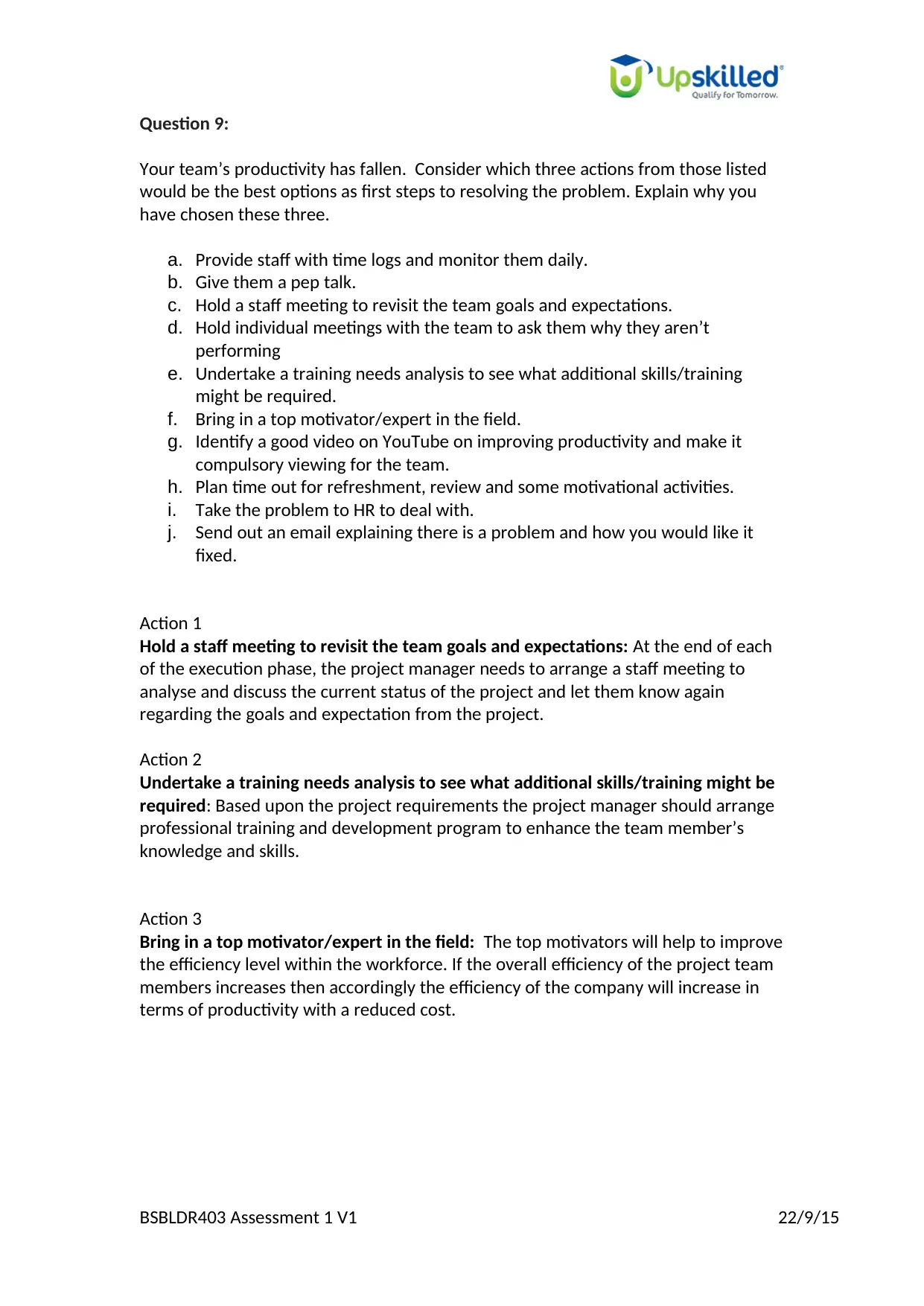
Question 9:
Your team’s productivity has fallen. Consider which three actions from those listed
would be the best options as first steps to resolving the problem. Explain why you
have chosen these three.
a. Provide staff with time logs and monitor them daily.
b. Give them a pep talk.
c. Hold a staff meeting to revisit the team goals and expectations.
d. Hold individual meetings with the team to ask them why they aren’t
performing
e. Undertake a training needs analysis to see what additional skills/training
might be required.
f. Bring in a top motivator/expert in the field.
g. Identify a good video on YouTube on improving productivity and make it
compulsory viewing for the team.
h. Plan time out for refreshment, review and some motivational activities.
i. Take the problem to HR to deal with.
j. Send out an email explaining there is a problem and how you would like it
fixed.
Action 1
Hold a staff meeting to revisit the team goals and expectations: At the end of each
of the execution phase, the project manager needs to arrange a staff meeting to
analyse and discuss the current status of the project and let them know again
regarding the goals and expectation from the project.
Action 2
Undertake a training needs analysis to see what additional skills/training might be
required: Based upon the project requirements the project manager should arrange
professional training and development program to enhance the team member’s
knowledge and skills.
Action 3
Bring in a top motivator/expert in the field: The top motivators will help to improve
the efficiency level within the workforce. If the overall efficiency of the project team
members increases then accordingly the efficiency of the company will increase in
terms of productivity with a reduced cost.
BSBLDR403 Assessment 1 V1 22/9/15
Your team’s productivity has fallen. Consider which three actions from those listed
would be the best options as first steps to resolving the problem. Explain why you
have chosen these three.
a. Provide staff with time logs and monitor them daily.
b. Give them a pep talk.
c. Hold a staff meeting to revisit the team goals and expectations.
d. Hold individual meetings with the team to ask them why they aren’t
performing
e. Undertake a training needs analysis to see what additional skills/training
might be required.
f. Bring in a top motivator/expert in the field.
g. Identify a good video on YouTube on improving productivity and make it
compulsory viewing for the team.
h. Plan time out for refreshment, review and some motivational activities.
i. Take the problem to HR to deal with.
j. Send out an email explaining there is a problem and how you would like it
fixed.
Action 1
Hold a staff meeting to revisit the team goals and expectations: At the end of each
of the execution phase, the project manager needs to arrange a staff meeting to
analyse and discuss the current status of the project and let them know again
regarding the goals and expectation from the project.
Action 2
Undertake a training needs analysis to see what additional skills/training might be
required: Based upon the project requirements the project manager should arrange
professional training and development program to enhance the team member’s
knowledge and skills.
Action 3
Bring in a top motivator/expert in the field: The top motivators will help to improve
the efficiency level within the workforce. If the overall efficiency of the project team
members increases then accordingly the efficiency of the company will increase in
terms of productivity with a reduced cost.
BSBLDR403 Assessment 1 V1 22/9/15
⊘ This is a preview!⊘
Do you want full access?
Subscribe today to unlock all pages.

Trusted by 1+ million students worldwide
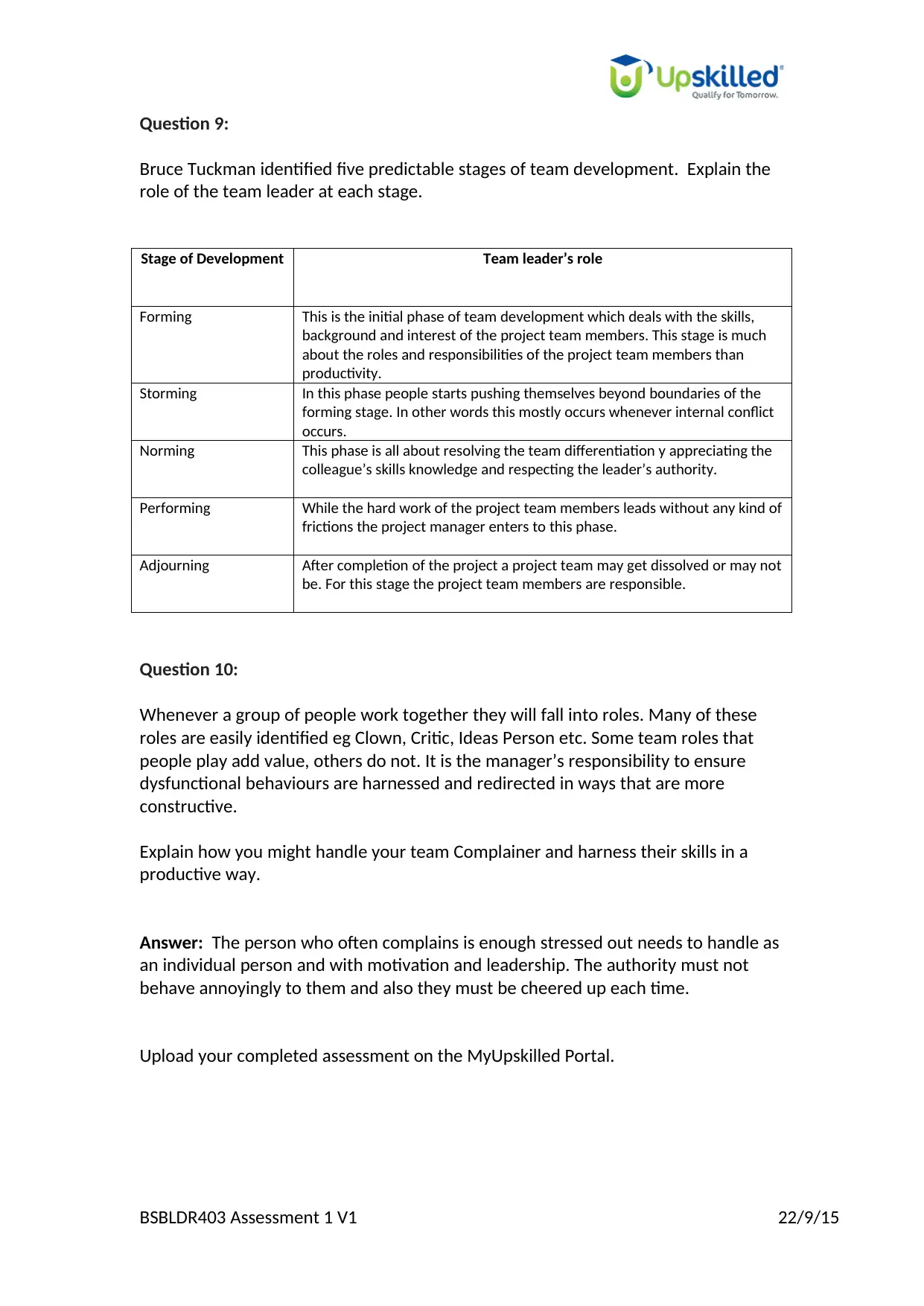
Question 9:
Bruce Tuckman identified five predictable stages of team development. Explain the
role of the team leader at each stage.
Stage of Development Team leader’s role
Forming This is the initial phase of team development which deals with the skills,
background and interest of the project team members. This stage is much
about the roles and responsibilities of the project team members than
productivity.
Storming In this phase people starts pushing themselves beyond boundaries of the
forming stage. In other words this mostly occurs whenever internal conflict
occurs.
Norming This phase is all about resolving the team differentiation y appreciating the
colleague’s skills knowledge and respecting the leader’s authority.
Performing While the hard work of the project team members leads without any kind of
frictions the project manager enters to this phase.
Adjourning After completion of the project a project team may get dissolved or may not
be. For this stage the project team members are responsible.
Question 10:
Whenever a group of people work together they will fall into roles. Many of these
roles are easily identified eg Clown, Critic, Ideas Person etc. Some team roles that
people play add value, others do not. It is the manager’s responsibility to ensure
dysfunctional behaviours are harnessed and redirected in ways that are more
constructive.
Explain how you might handle your team Complainer and harness their skills in a
productive way.
Answer: The person who often complains is enough stressed out needs to handle as
an individual person and with motivation and leadership. The authority must not
behave annoyingly to them and also they must be cheered up each time.
Upload your completed assessment on the MyUpskilled Portal.
BSBLDR403 Assessment 1 V1 22/9/15
Bruce Tuckman identified five predictable stages of team development. Explain the
role of the team leader at each stage.
Stage of Development Team leader’s role
Forming This is the initial phase of team development which deals with the skills,
background and interest of the project team members. This stage is much
about the roles and responsibilities of the project team members than
productivity.
Storming In this phase people starts pushing themselves beyond boundaries of the
forming stage. In other words this mostly occurs whenever internal conflict
occurs.
Norming This phase is all about resolving the team differentiation y appreciating the
colleague’s skills knowledge and respecting the leader’s authority.
Performing While the hard work of the project team members leads without any kind of
frictions the project manager enters to this phase.
Adjourning After completion of the project a project team may get dissolved or may not
be. For this stage the project team members are responsible.
Question 10:
Whenever a group of people work together they will fall into roles. Many of these
roles are easily identified eg Clown, Critic, Ideas Person etc. Some team roles that
people play add value, others do not. It is the manager’s responsibility to ensure
dysfunctional behaviours are harnessed and redirected in ways that are more
constructive.
Explain how you might handle your team Complainer and harness their skills in a
productive way.
Answer: The person who often complains is enough stressed out needs to handle as
an individual person and with motivation and leadership. The authority must not
behave annoyingly to them and also they must be cheered up each time.
Upload your completed assessment on the MyUpskilled Portal.
BSBLDR403 Assessment 1 V1 22/9/15
1 out of 7
Related Documents
Your All-in-One AI-Powered Toolkit for Academic Success.
+13062052269
info@desklib.com
Available 24*7 on WhatsApp / Email
![[object Object]](/_next/static/media/star-bottom.7253800d.svg)
Unlock your academic potential
Copyright © 2020–2025 A2Z Services. All Rights Reserved. Developed and managed by ZUCOL.




